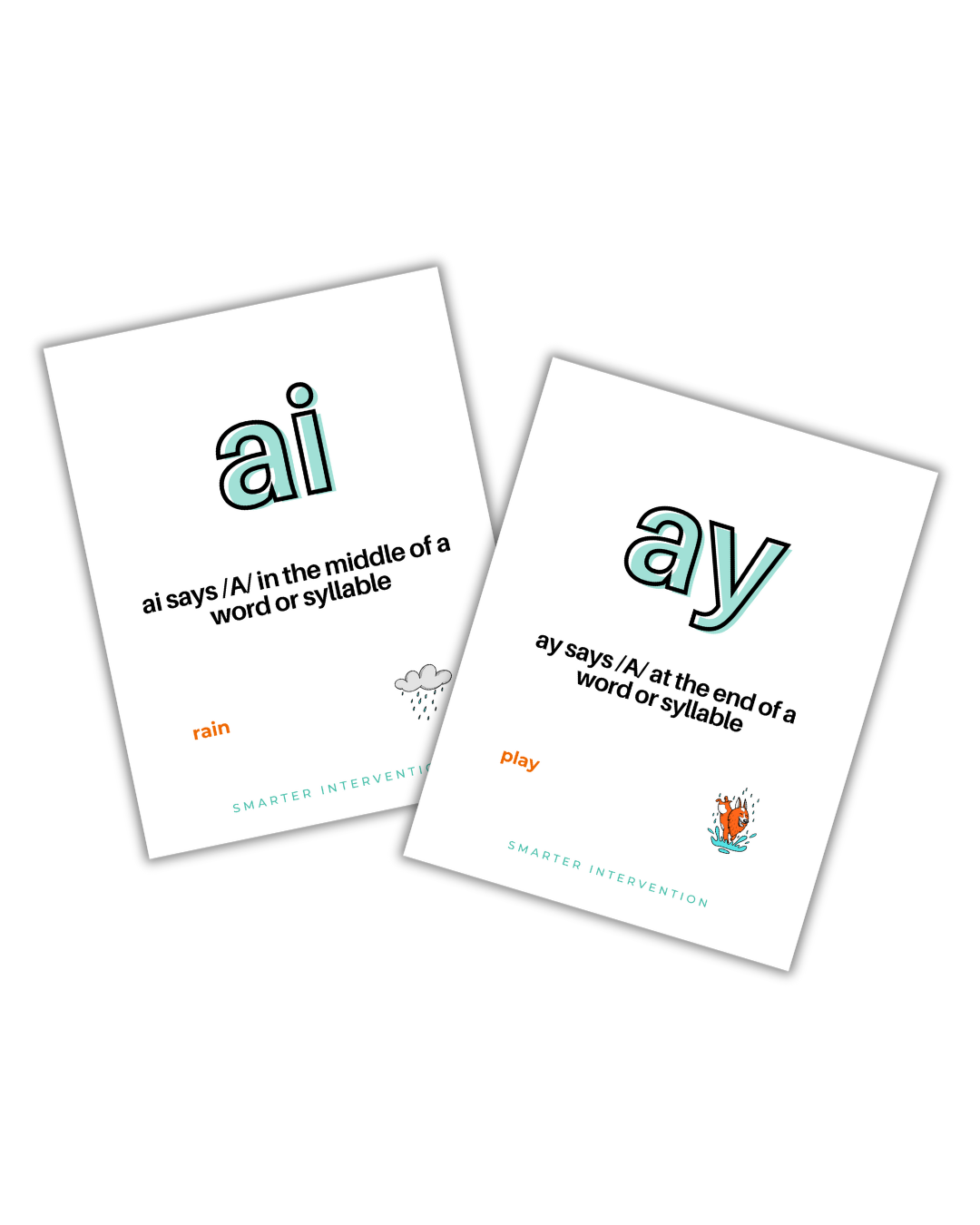How to Teach the ai/ay Spelling Rule
Why it Matters
Teaching long vowel patterns can feel like a maze, especially with so many ways to spell them!
Let’s think about the long A sound. If your students are stuck guessing between ai, ay, a_e, or any of the other ways we might spell this pattern (ea, eigh, ei, etc.) they’re not alone.
That’s why it’s so important to teach these spelling patterns clearly and systematically. When students understand where ai and ay show up in words (and why), they can read and spell more confidently.
What is the ai/ay rule?
Here’s the simple breakdown:
Use ai when the long A sound comes in the middle of a syllable: rain, train, pail.
Use ay when the long A sound is at the end of a word or syllable: day, play, Sunday.
How we teach the ai & ay spelling patterns -
We teach spelling by moving from sound to application, so students understand not just how to memorize a word, but how the sound patterns work and when to use them in context.
Here’s the step-by-step process we use:
1. Introduce the Sound in Isolation
We start by teaching that /ā/ (the long A sound) can be spelled with AI or AY:
AI is used in the middle of a syllable or word (e.g., rain, train, mail)
AY is used at the end of a base word (e.g., play, stay, tray)
We anchor this with the phrase:
“Play in the rain” — to reinforce both patterns.
Students say the sound, identify the spelling options, and sort example words by spelling placement.
2. Connect to Syllable Structure
Next, we show students that AI and AY are vowel team spelling options for the /ā/ sound. We talk about how different syllable types may influence spelling:
In an open syllable, we might see a say its name (e.g., ba-sic)
In magic e syllables, we use a_e (e.g., cake)
In vowel team syllables, we can use AI or AY (and a few other options as you can see in the pie chart!)
This helps students see AI/AY as one piece of a bigger pattern system, not just random choices.
3. Practice at the Word Level (with Vocabulary & Homonyms)
At this stage, we help students connect sound to meaning. We teach:
Common homonyms like mail/male, plain/plane, tail/tale
Word sorts and definition matching to reinforce which spelling matches which word
We want students to understand what the words mean, not just how they’re spelled.
4. Move to the Sentence Level (Sentence Writing & Dictation)
We use a three-part sentence routine to deepen application:
Sentence Building – Students choose two AI/AY words and write their own sentence.
Sentence Combining – Students combine two given sentences using different AI/AY words.
Sentence Dictation – We say a full sentence out loud, and students write it using correct spelling, capitalization, and punctuation.
This reinforces grammar, mechanics, and spelling, all in one! There’s a win!!
5. Optional Paragraph Writing (Grades 2 and Up)
For older or more advanced students, we extend the pattern to the paragraph level:
Students select 4–5 words from an AI/AY word list
Then they draft a short paragraph that uses all their words in context
This helps build flexibility and fluency, and gives us insight into how well students can transfer the spelling pattern into real writing.
What if students get stuck?
Students often confuse ai/ay with:
Magic E patterns (e.g., made, cake)
Homophones (plain vs. plane, pail vs. pale)
We embrace these moments as vocabulary wins. Prompt students to define, compare, and sort tricky pairs. Ask:
“Which one tells a story: tail or tale?”
“Which one means light in color: pale or pail?”
The key is giving students lots of exposure, discussion, and feedback, not just correction.
For older students, we might also point them to the frequency of patterns - which pattern is most common in this case? We have an entire guide on this in our “Reading (and Spelling) Rules We Teach” training! In all seriousness, it’s called “Reading Rules We Teach,” but the reading and spelling process is reciprocal!
Looking to teach ai & ay in your lessons?
Depending on where you are in your teaching journey, here are a few next steps:
Just getting started?
Grab our free phonics rules posters! These are the foundation we use to introduce every major reading (and spelling!) rule, including AI/AY as vowel team syllables.
Download the Free Phonics Rules Posters » Get them here!
Want to see how we teach all the rules?
Check out our Spotlight PD: The Reading Rules We Teach (and Why They Matter!)
This on-demand training provides you with everything you need to help you confidently teach the rules that actually move the needle, without getting lost in all the complexity.
You’ll get a clear, research-backed framework that shows which reading rules to focus on, why they matter for the brain, and how to teach them at each level—sound, syllable, word, sentence, paragraph, and passage.




